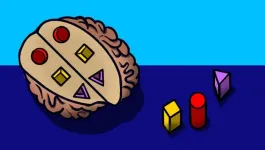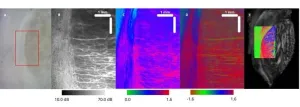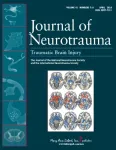(Press-News.org) Cognitive behavioral therapy, one of the most common treatments for depression, can teach skills for coping with everyday troubles, reinforce healthy behaviors and counter negative thoughts. But can altering thoughts and behaviors lead to lasting changes in the brain?
New research led by Stanford Medicine has found that it can — if a therapy is matched with the right patients. In a study of adults with both depression and obesity — a difficult-to-treat combination — cognitive behavioral therapy that focused on problem solving reduced depression in a third of patients. These patients also showed adaptative changes in their brain circuitry.
Moreover, these neural adaptations were apparent after just two months of therapy and could predict which patients would benefit from long-term therapy.
The findings add to evidence that choosing treatments based on the neurological underpinnings of a patient’s depression — which vary among people — increases the odds of success.
The same concept is already standard practice in other medical specialties.
“If you had chest pain, your physician would suggest some tests — an electrocardiogram, a heart scan, maybe a blood test — to work out the cause and which treatments to consider,” said Leanne Williams, PhD, the Vincent V.C. Woo Professor, a professor of psychiatry and behavioral sciences, and the director of Stanford Medicine’s Center for Precision Mental Health and Wellness.
“Yet in depression, we have no tests being used. You have this broad sense of emotional pain, but it’s a trial-and-error process to choose a treatment, because we have no tests for what is going on in the brain.”
Williams and Jun Ma, MD, PhD, professor of academic medicine and geriatrics at the University of Illinois at Chicago, are co-senior authors of the study published Sept. 4 in Science Translational Medicine. The work is part of a larger clinical trial called RAINBOW (Research Aimed at Improving Both Mood and Weight).
Problem solving
The form of cognitive behavioral therapy used in the trial, known as problem-solving therapy, is designed to improve cognitive skills used in planning, troubleshooting and tuning out irrelevant information. A therapist guides patients in identifying real-life problems — a conflict with a roommate, say — brainstorming solutions and choosing the best one.
These cognitive skills depend on a particular set of neurons that function together, known as the cognitive control circuit.
Previous work from Williams’ lab, which identified six biotypes of depression based on patterns of brain activity, estimated that a quarter of people with depression have dysfunction with their cognitive control circuits — either too much or too little activity.
The participants in the new study were adults diagnosed with both major depression and obesity, a confluence of symptoms that often indicates problems with the cognitive control circuit. Patients with this profile generally do poorly on antidepressants: They have a dismal response rate of 17%.
Of the 108 participants, 59 underwent a year-long program of problem-solving therapy in addition to their usual care, such as medications and visits to a primary care physician. The other 49 received only usual care.
They were given fMRI brain scans at the beginning of the study, then after two months, six months, 12 months and 24 months. During the brain scans, the participants completed a test that involves pressing or not pressing a button according to text on a screen — a task known to engage the cognitive control circuit. The test allowed the researchers to gauge changes in the activity of that circuit throughout the study.
“We wanted to see whether this problem-solving therapy in particular could modulate the cognitive control circuit,” said Xue Zhang, PhD, a postdoctoral scholar in psychiatry who is the lead author of the study.
With each brain scan, participants also filled out standard questionnaires that assessed their problem-solving ability and depression symptoms.
Working smarter
As with any other depression treatment, problem-solving therapy didn’t work for everyone. But 32% of participants responded to the therapy, meaning their symptom severity decreased by half or more.
“That’s a huge improvement over the 17% response rate for antidepressants,” Zhang said.
When researchers examined the brain scans, they found that in the group receiving only usual care, a cognitive control circuit that became less active over the course of the study correlated with worsening problem-solving ability.
But in the group receiving therapy, the pattern was reversed: Decreased activity correlated with enhanced problem-solving ability. The researchers think this may be due to their brains learning, through the therapy, to process information more efficiently.
“We believe they have more efficient cognitive processing, meaning now they need fewer resources in the cognitive control circuit to do the same behavior,” Zhang said.
Before the therapy, their brains had been working harder; now, they were working smarter.
Both groups, on average, improved in their overall depression severity. But when Zhang dug deeper into the 20-item depression assessment, she found that the depression symptom most relevant to cognitive control — “feeling everything is an effort” — benefited from the more efficient cognitive processing gained from the therapy.
“We’re seeing that we can pinpoint the improvement specific to the cognitive aspect of depression, which is what drives disability because it has the biggest impact on real-world functioning,” Williams said.
Indeed, some participants reported that problem-solving therapy helped them think more clearly, allowing them to return to work, resume hobbies and manage social interactions.
Fast track to recovery
Just two months into the study, brain scans showed changes in cognitive control circuit activity in the therapy group.
“That’s important, because it tells us that there is an actual brain change going on early, and it’s in the time frame that you’d expect brain plasticity,” Williams said. “Real-world problem solving is literally changing the brain in a couple of months.”
The idea that thoughts and behaviors can modify brain circuits is not so different from how exercise — a behavior — strengthens muscles, she added.
The researchers found that these early changes signaled which patients were responding to the therapy and would likely improve on problem-solving skills and depression symptoms at six months, 12 months and even one year after the therapy ended, at 24 months. That means a brain scan could be used to predict which patients are the best candidates for problem-solving therapy.
It’s a step toward Williams’ vision of precision psychiatry — using brain activity to match patients with the therapies most likely to help them, fast-tracking them to recovery.
“It’s definitely advancing the science,” Zhang said. “But it’s also going to transform a lot of people’s lives.”
Researchers from University of Washington, University of Pittsburgh School of Medicine and The Ohio State University also contributed to the work.
The study received funding from the National Institutes of Health (grants UH2 HL132368, UH3 HL132368 and R01 HL119453).
Listen to a podcast of Leanne Williams discussing depression biotypes.
END
Cognitive behavioral therapy enhances brain circuits to relieve depression
2024-09-06
ELSE PRESS RELEASES FROM THIS DATE:
Terasaki Institute awarded $2.3 Million grant from NIH for organ transplantation research using organs-on-a-chip technology
2024-09-06
September 6, 2024 —Researchers at the Terasaki Institute for Biomedical Innovation have been awarded a multi-million grant from the National Institutes of Health (NIH) to advance research in organ transplantation and antibody-mediated rejection. This funding will facilitate the development of an innovative multi-organs-on-a-chip platform aimed at transforming our understanding of transplant rejection and immune tolerance.
Organ transplantation is widely recognized as the most effective treatment for organ failure. However, the need for lifelong immunosuppressive ...
Atoms on the edge
2024-09-06
Typically, electrons are free agents that can move through most metals in any direction. When they encounter an obstacle, the charged particles experience friction and scatter randomly like colliding billiard balls.
But in certain exotic materials, electrons can appear to flow with single-minded purpose. In these materials, electrons may become locked to the material’s edge and flow in one direction, like ants marching single-file along a blanket’s boundary. In this rare “edge state,” electrons can flow without ...
Postdoc takes multipronged approach to muon detection
2024-09-06
NEWPORT NEWS, VA – When Debaditya Biswas was a high school student in India, his math teacher, Dr. Satyabrata Das, sparked his interest in physics.
“Before I joined his class, I was really not sure what I was going to do in life,” said Biswas, a postdoctoral research associate at Virginia Tech. “He revealed the beauty of science to me.”
Now, as the 2024 Jefferson Science Associates (JSA) Postdoctoral Prize winner, Biswas hopes to reveal a new method for the U.S. Department of Energy's Thomas Jefferson National Accelerator Facility to detect muons.
By themselves, muons aren’t actually that difficult for physicists to detect. They are a type ...
Mathematical proof: Five satellites needed for precise navigation
2024-09-06
As a rule, GPS indicates our location with an accuracy of just a few meters. But we have all experienced situations where the possible error increases to a few hundred meters or the indicated location is simply wrong. One reason for this can be the small number of satellites with line-of-sight contact to the navigation device or unfavorable relative alignment of the satellites.
How does GPS work?
GPS satellites are equipped with an extremely accurate atomic clock and know their positions at all times. They continually transmit the time and their location using radio waves. A mobile phone ...
Scalable, multi-functional device lays groundwork for advanced quantum applications
2024-09-06
Researchers have demonstrated a new multi-functional device that could help advance the scalability of solid-state color centers, enabling them to be used in larger and more complex quantum computers and networks. As efficient photon-spin interfaces, solid-state color centers are promising candidates for qubit nodes — essential units for storing and processing quantum information.
Solid-state color centers are point defects that can absorb and emit light at specific wavelengths. To be useful in real-world quantum applications, they must be optically addressable in a fast and controllable manner while also allowing ...
Falling for financial scams? It may signal early Alzheimer’s disease
2024-09-06
Older adults who are more vulnerable to financial scams may have brain changes linked to a higher risk of Alzheimer’s disease, according to a first-of-its-kind study led by researchers at the USC Dornsife College of Letters, Arts and Sciences.
Nearly 7 million Americans are living with Alzheimer’s disease, the fifth leading cause of death among those 65 and older. The disease will carry an estimated $360 billion in health care costs this year alone, according to the Alzheimer’s Association.
Researchers led by Duke Han, professor ...
Integrating MRI and OCT for new insights into brain microstructure
2024-09-06
In a new study, researchers compared the orientations of nerve fibers in a human brainstem using two advanced imaging techniques: diffusion magnetic resonance imaging (dMRI)-based tractography and polarization sensitive optical coherence tomography (PS-OCT). The findings could aid in combining these techniques, which each offer unique advantages, to advance our understanding of the brain’s microstructure and help inform new techniques for early diagnosis of various brain disorders.
Isabella Aguilera-Cuenca from ...
Designing a normative neuroimaging library to support diagnosis of traumatic brain injury
2024-09-06
With recent advances in neuroimaging, moving from qualitative to quantitative outputs, an understanding is needed of what normal data look like to be able to apply these advances to diagnosis and outcomes prediction in traumatic brain injury (TBI). A new article in the peer-reviewed Journal of Neurotrauma introduces the large Normative Neuroimaging Library (NLL) to the research community. Click here to read the article now.
The American College of Radiology and Cohen Veterans Bioscience created a reference ...
Department of Energy announces $68 million in funding for artificial intelligence for scientific research
2024-09-06
WASHINGTON, D.C. - The use of Artificial Intelligence (AI) in scientific research is a top priority at the Department of Energy (DOE), which today announced $68 million in funding for 11 multi-institution projects, comprising 43 awards.
The funded projects will develop new ways to create foundation models, which are machine learning or deep learning models that can be used across a wide range of applications because they’re trained on broad data. Foundation models are a key building block of AI.
Those models will be used in computational science, to automate workflow in laboratories, to accelerate scientific programming, and much more. The possibilities ...
DOE, ORNL announce opportunity to define future of high-performance computing
2024-09-06
The Department of Energy’s (DOE) Office of Science today announced a new research and development opportunity led by Oak Ridge National Laboratory (ORNL) to advance technologies and drive new capabilities for future supercomputers. This industry research program worth $23 million, called New Frontiers, will initiate partnerships with multiple companies to accelerate the R&D of critical technologies with renewed emphasis on energy efficiency for the next generation of post-exascale computing in the 2029 and beyond time frame.
“There is a growing consensus that urgent action is needed to address an array of bottlenecks ...






